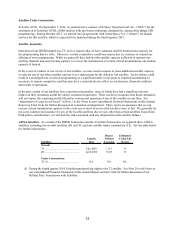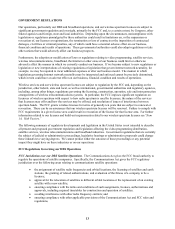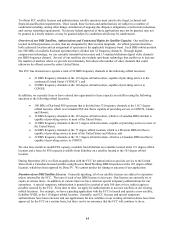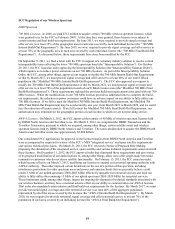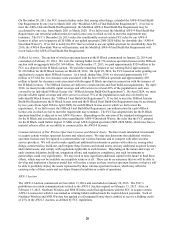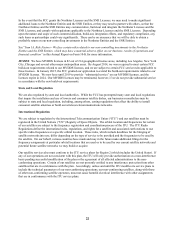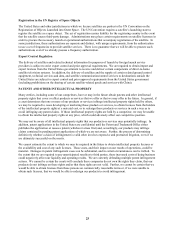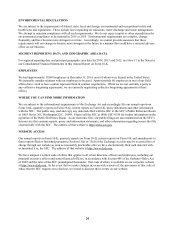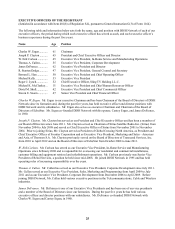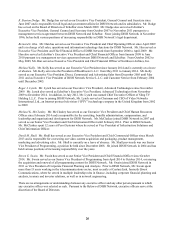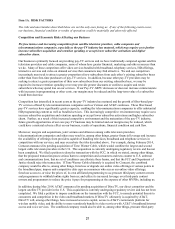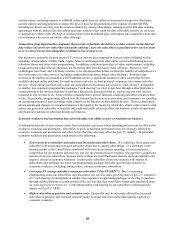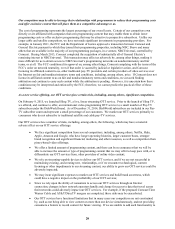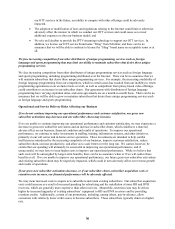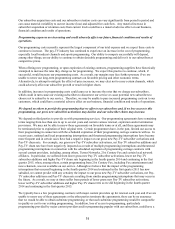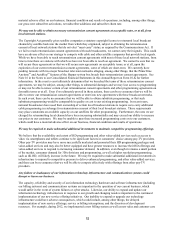Dish Network 2014 Annual Report Download - page 32
Download and view the complete annual report
Please find page 32 of the 2014 Dish Network annual report below. You can navigate through the pages in the report by either clicking on the pages listed below, or by using the keyword search tool below to find specific information within the annual report.22
22
In the event that the FCC grants the Northstar Licenses and the SNR Licenses, we may need to make significant
additional loans to the Northstar Entities and the SNR Entities, or they may need to partner with others, so that the
Northstar Entities and the SNR Entities may commercialize, build-out and integrate the Northstar Licenses and the
SNR Licenses, and comply with regulations applicable to the Northstar Licenses and the SNR Licenses. Depending
upon the nature and scope of such commercialization, build-out, integration efforts, and regulatory compliance, any
such loans or partnerships could vary significantly. There can be no assurance that we will be able to obtain a
profitable return on our non-controlling investments in the Northstar Entities and the SNR Entities.
See “Item 1A. Risk Factors - We face certain risks related to our non-controlling investments in the Northstar
Entities and the SNR Entities, which may have a material adverse effect on our business, results of operations and
financial condition” in this Annual Report on Form 10-K for more information.
MVDDS. We have MVDDS licenses in 82 out of 214 geographical license areas, including Los Angeles, New York
City, Chicago and several other major metropolitan areas. By August 2014, we were required to meet certain FCC
build-out requirements related to our MVDDS licenses, and we are subject to certain FCC service rules applicable to
these licenses. In January 2015, the FCC granted our application to extend the build-out requirements related to our
MVDDS licenses. We now have until 2019 to provide “substantial service” on our MVDDS licenses, and the
licenses expire in 2024. Our MVDDS licenses may be terminated, however, if we do not provide substantial service
in accordance with the new build-out requirements.
State and Local Regulation
We are also regulated by state and local authorities. While the FCC has preempted many state and local regulations
that impair the installation and use of towers and consumer satellite dishes, our businesses nonetheless may be
subject to state and local regulation, including, among others, zoning regulations that affect the ability to install
consumer satellite antennas or build out wireless telecommunications networks.
International Regulation
We are subject to regulation by the International Telecommunication Union (“ITU”) and our satellites must be
registered in the United Nations (“UN”) Registry of Space Objects. The orbital location and frequencies for certain
of our satellites are subject to the frequency registration and coordination process of the ITU. The ITU Radio
Regulations define the international rules, regulations, and rights for a satellite and associated earth stations to use
specific radio frequencies at a specific orbital location. These rules, which include deadlines for the bringing of
satellite networks into use, differ depending on the type of service to be provided and the frequencies to be used by
the satellite. On our behalf, various countries have made and may in the future make additional filings for the
frequency assignments at particular orbital locations that are used or to be used by our current satellite networks and
potential future satellite networks we may build or acquire.
Our satellite services also must conform to the ITU service plans for Region 2 (which includes the United States). If
any of our operations are not consistent with this plan, the ITU will only provide authorization on a non-interference
basis pending successful modification of the plan or the agreement of all affected administrations to the non-
conforming operations. Certain of our satellites are not presently entitled to any interference protection from other
satellites that are in conformance with the plan. Accordingly, unless and until the ITU modifies its service plans to
include the technical parameters of our non-conforming operations, our non-conforming satellites, along with those
of other non-conforming satellite operators, must not cause harmful electrical interference with other assignments
that are in conformance with the ITU service plans.


